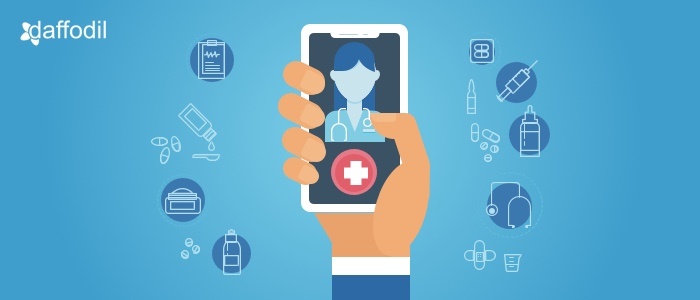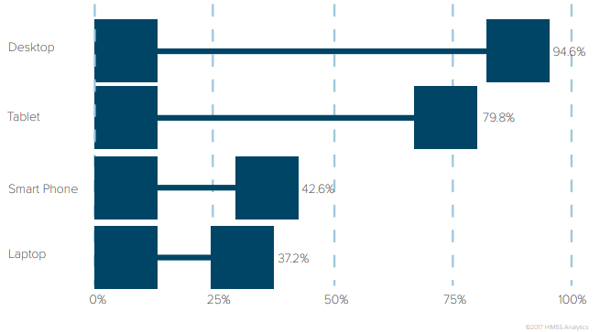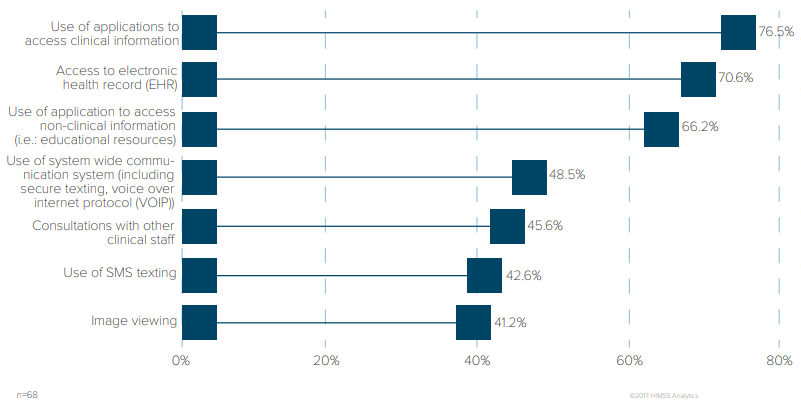
Businesses, irrespective of the domain are realizing the benefits of new technologies and models that originate and develop in consumer space. This impact, called consumerization has been affecting (almost) every industry and healthcare is no exception.
Mobile devices have a pronounced role in consumerization of healthcare. The popularity of mobile devices and solutions (at consumer level) can be estimated from the fact that over 3.7 billion mobile health apps were downloaded in the year 2017. And Health Delivery Organizations are making the most of this consumer-centric technology trend.
Regardless of being hospital provided or bring-your-own-device (BYOD), healthcare employers have been using smartphones and tablets to coordinate, support, and provide patient care.
According to a survey by HIMSS Analytics, the use of mobile devices in the hospitals across US has been quite prominent. The survey participants (C-Suite, IT professionals, clinicians, department heads) gave a snapshot of how the mobile technology, especially smartphones and tablets are used to improve clinical processes and communication.
- 79.8% of healthcare providers said that they use tablets, while 42.6% use smartphones to coordinate and provide patient care.

- 76.5% of the survey participants indicated they use them to access clinical information
- 70.6% use mobile devices to access EHRs while 66.2% use it to access non-clinical information (like educational resources)
- 48.5% (nearly half of the survey respondents) said that they use mobile devices for systemwide communication.

And it's not just the healthcare providers who are realizing the benefits of mobility. With patients having active interest in managing their health, mobile devices (wearables, mHealth apps) are helping them to manage and improve their health in various innovative ways. According to a survey results by Statista, the top reasons for U.S. adults for adopting e-health applications or devices include:
- Ability to take better control over health
- Improve health, fitness, and have more information
- Ability to reduce healthcare cost
- Ability to access healthcare providers conveniently
- More transparency regarding health/fitness
The rise of this collaborative approach (by patients and providers) to healthcare is enabling a system of care, which is cost-efficient, on-time, and is value-bases. By making the most of mobile devices- which are already a significant part of the consumer’s life (the patients), providers have the advantage delivering patient-centric care, while also collecting data that can help them in achieving better and most expectant outcomes.
Today, when both patients and providers are a part of the mobile healthcare system, better care in the form of patient engagement, remote monitoring, telehealth visits can be deployed. Let’s talk in detail, how.
1. On-Demand, Two-Way Conversations
With the advent of messaging platforms, connecting with people for instantaneous response have been a possibility. With patient engagement technologies, clinicians and patients can use mobile devices to have secured, two-way conversation, which could happen through modern way of communication (text, video, or audio).
When patients engage with the care providers in an open ended communication, it breaks down the communication barriers, making patients more comfortable with physicians, thereby elaborating their health conditions in a better way. Not only does it adds patient satisfaction but also increase the chances of identifying adverse health events at an early stage.
2. Share Relevant Information with Patients
Patients are concerned about their health, more than ever. That is why, they take an accountability for tracking and improving their health, with the most convenient mode available to them.
mHealth apps have been a great source for individuals and patients to access care information, with the touch of a button. Also, mHealth apps help in chronic disease management, which requires regular monitoring of health vitals and ongoing communication with physicians to maintain good health.
According to Center for Chronic Disease Control (CDC), 75 percent of nation’s aggregate healthcare spending is done for chronic diseases, which is estimated to be 5,300 USD/person in the U.S.
Patient engagement portals or mhealth apps can enable care providers to customize the treatment plan, in accordance to each phase of patient’s healthcare journey. For example: A patient discharged from the hospital after a cardiac attack needs to follow a controlled diet plan and regular heart beat tracking.
mHealth apps can help patients to communicate with doctors, whenever they want, while wearables are a major source for tracking the health vitals. When patients follow the instructions and continue to share their health vitals with the doctor, they are likely to avoid readmissions or severe conditions in time to come.
3. Maintain Health Records for Anytime Access
Mobile devices such as mhealth apps, wearables enable patients to capture real-time data, save it, and then share it with their physicians. This not only maintains a record of patient’s health history but also helps in e-consultation.
Also, what gives the patients to use and save their health-data electronically is the regulations and compliances the restrict providers from sharing or using it without user’s consent. HIPPA, FDA, HITECH are the compliances that the healthcare system against breaches and unauthorized access/usage.
Patient engagement portals that secure personal health information are likely to get users’ trust, encouraging them to reap its benefits and allow providers to do the same. Electronically saved health records are further integrated with EHRs that ensure that helps to manage both inpatient and outpatient functionality within a HDO.
With consumerization holding the front-seat in patient-centric care delivery model, it’s high time the care providers start to integrate their care solutions with the mobile lifestyle of patients. To understand how mobile based solutions can simplify care delivery, take a look at how a Nairobi based healthcare organization did it with iSikCure.



